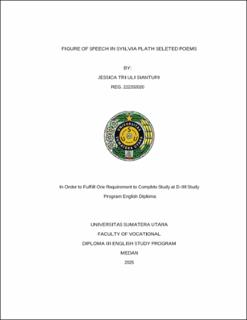Figure of Speech in Sylvia Plath Selected Poems
Figure of Speech in Sylvia Plath Selected Poems

Date
2025Author
Sianturi, Jessica Tri Uli
Advisor(s)
Lubis, Swesana Mardia
Metadata
Show full item recordAbstract
Background: Figure of speech is a language style used to convey meaning indirectly, with the aim of causing certain effects in the thoughts or feelings of readers or listeners.
Objective: This study aims to describe what kinds of figures of speech are contained in Sylvia Plath's poetry.
Methods: This study uses a qualitative descriptive method by identifying types of figurative language such as metaphor, personification, simile, irony, synecdoche, hyperbole, metonymy, sarcasm, and paradox.
Results: The most dominant figurative language is metaphor. It dominates because it compares two things directly without using comparative words to convey a deeper or symbolic meaning.
Conclusion: One of the most dominant figurative language in Sylvia Plath's poetry is metaphor with 31.% data. Metaphors are often found in poems that contain deep
psychological, intense emotions, and dark personal experiences, especially those related to identity, death, depression, family relations, and the role of women. These can be found in the poems The Moon and the Yew Tree, Mirror, Morning Song, Metaphors and Contusion.
Keywords: figure of speech , metaphors, poetry, Sylvia Plath.
Collections
- Diploma Papers [199]
